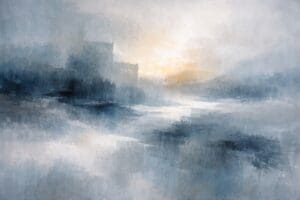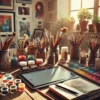Troubleshooting Common Watercolor Mistakes: Tips for Beginners
Watercolor painting is a delightful and expressive medium, but it can also be challenging for beginners. As you embark on your artistic journey, you may encounter a variety of common mistakes that can be frustrating. This comprehensive guide will explore these issues and provide practical solutions, helping you to improve your skills and enjoy the process of creating beautiful watercolor artworks.
1. Understanding Watercolor Basics
Before diving into troubleshooting, it’s essential to understand the basic elements of watercolor painting:
- Watercolor Paper: Use high-quality, 100% cotton or cold-pressed watercolor paper, which can handle water better than regular paper.
- Brushes: Invest in a few good watercolor brushes (round and flat) that can hold water and paint well.
- Paint: Choose artist-grade watercolor paints for better pigmentation and blending.
- Water: Use clean water for mixing and rinsing brushes.
Image Idea: A neatly organized watercolor setup, including paper, brushes, paints, and water.
2. Common Watercolor Mistakes and Solutions
2.1. Too Much Water
Mistake: One of the most frequent mistakes beginners make is using too much water, resulting in overly diluted colors that lack vibrancy.
Solution:
- Control Water Usage: Use a damp brush rather than a wet one. Practice loading your brush with paint before adding water.
- Practice on Scrap Paper: Experiment with different water-to-paint ratios on scrap paper to find the ideal consistency for your style.
2.2. Muddy Colors
Mistake: Mixing too many colors can lead to muddy or dull results.
Solution:
- Limit Color Mixing: Stick to a limited palette of colors that complement each other. Understanding color theory can help you create harmonious color blends.
- Layering: Instead of mixing colors on your palette, layer washes to create depth without losing vibrancy.
Image Idea: A color wheel with examples of complementary colors.
2.3. Overworking the Paint
Mistake: Going back over areas that have already dried can lift the color and create an unwanted effect.
Solution:
- Work in Sections: Focus on one area at a time and let it dry before moving on.
- Embrace Imperfection: Sometimes, the beauty of watercolor lies in its spontaneity. Allow yourself to accept imperfections.
2.4. Unintended Blooms
Mistake: Blooms occur when wet paint is applied over a damp area, causing the colors to spread uncontrollably.
Solution:
- Timing is Key: Wait for the first layer to dry completely before applying the next wash.
- Use a Dry Brush Technique: This technique allows you to control how much paint is applied, preventing unwanted blooms.
Image Idea: A visual demonstration of blooms in watercolor and how to prevent them.
2.5. Incorrect Brush Techniques
Mistake: Beginners often use the wrong brush techniques, leading to unintended marks or textures.
Solution:
- Practice Basic Strokes: Spend time practicing basic brush strokes on scrap paper, such as washes, dry brushing, and wet-on-wet techniques.
- Watch Tutorials: Online tutorials can provide valuable demonstrations of various brush techniques.
2.6. Lack of Planning
Mistake: Diving into a painting without a clear plan can lead to frustration and lackluster results.
Solution:
- Sketch First: Lightly sketch your composition before applying paint to help guide your work.
- Create a Color Chart: Make a color chart to test colors before using them in your artwork.
Image Idea: A sketch of a watercolor painting with color swatches.
2.7. Skipping the Right Tools
Mistake: Using subpar tools can hinder your painting experience.
Solution:
- Invest in Quality Supplies: While it may be tempting to save money, using high-quality brushes, paper, and paints can significantly impact your results.
- Use Masking Fluid: This can protect areas of your painting from unwanted color.
2.8. Neglecting Composition
Mistake: Ignoring the principles of composition can result in unbalanced or confusing artworks.
Solution:
- Learn Composition Rules: Familiarize yourself with principles such as the rule of thirds, balance, and focal points.
- Use Reference Images: Study compositions in other artworks or photographs to understand how to arrange elements effectively.
Image Idea: Examples of balanced and unbalanced compositions.
2.9. Not Understanding Color Theory
Mistake: Failing to grasp basic color theory can lead to ineffective color choices.
Solution:
- Study Color Theory: Familiarize yourself with the color wheel, complementary colors, and color harmony.
- Experiment: Play with color combinations to see how they interact and create different moods in your work.
2.10. Forgetting to Clean Brushes
Mistake: Not cleaning brushes properly can lead to dried paint and ruined brushes.
Solution:
- Establish a Cleaning Routine: Rinse brushes immediately after use and reshape them to maintain their form.
- Use Brush Soap: Occasionally, use a gentle brush soap to remove built-up paint.
3. Additional Tips for Watercolor Beginners
3.1. Patience is Key
Watercolor requires patience and practice. Allow yourself time to develop your skills without rushing the process.
3.2. Keep a Watercolor Journal
Maintain a journal to document your progress, practice new techniques, and experiment with colors. This will help you track your growth and areas for improvement.
3.3. Join a Community
Engage with other artists by joining local art groups or online communities. Sharing experiences and receiving feedback can significantly enhance your learning experience.
Image Idea: A group of artists painting together in a workshop setting.
4. Conclusion
Watercolor painting can be a rewarding experience, filled with moments of beauty and discovery. By understanding and troubleshooting common mistakes, you can enhance your skills and enjoy the journey of creating art. Remember, practice makes perfect, and every mistake is an opportunity to learn and grow.
*For collaborations, art features, or inquiries, please contact us at [email protected]. Don’t forget to follow us on Instagram, Facebook, Twitter.
Disclaimer: The views and opinions expressed in this article do not necessarily reflect the official policy or position of Irish Artmart.
Irish Artmart – Your Gateway to Artistic Excellence.
Tips to Express Your Creative Vision – Irish Artmart Podcast




